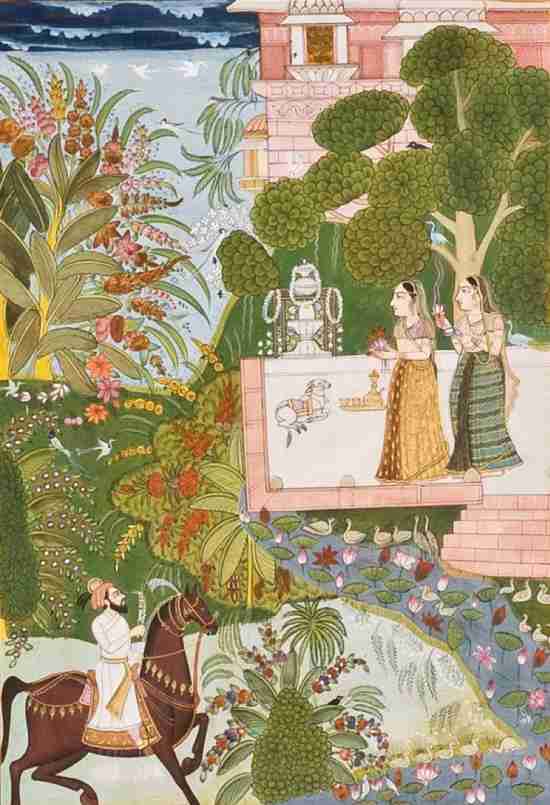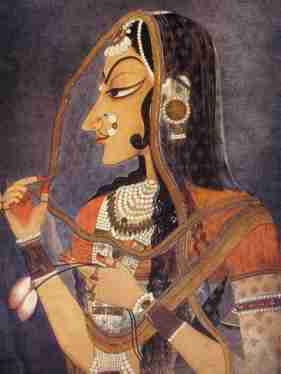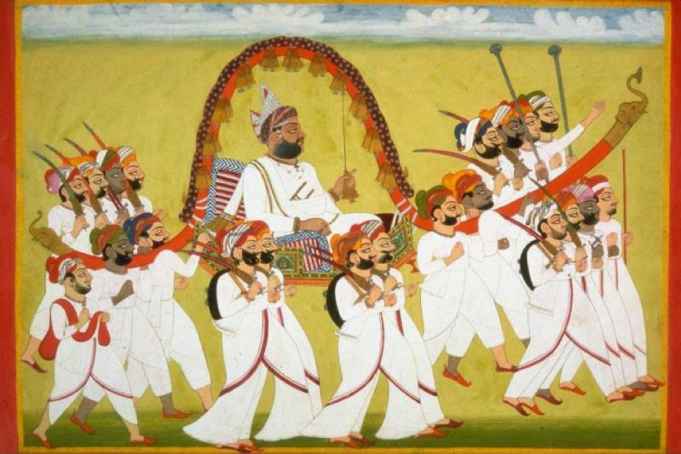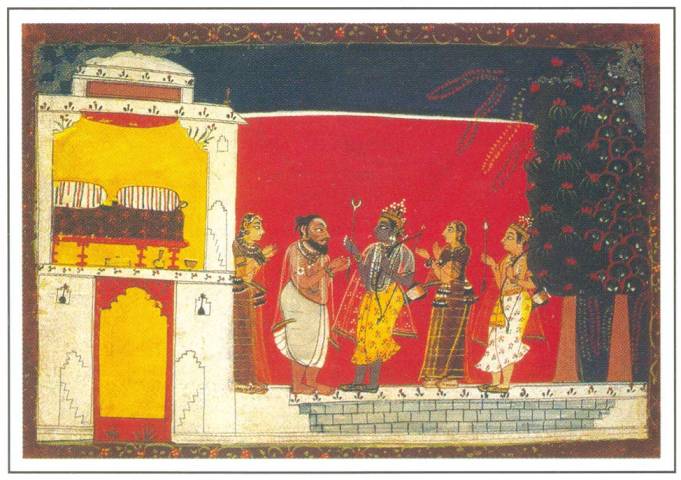The royal state of Rajasthan played an important role in the origination of the unique art form of Rajput Paintings, in between the late 16th and early 17th Century A.D. A strong Mughal influence can be seen in the Rajput Paintings since most of the princely states in Rajasthan were ruled by the Mughals. Evolved with distinct styles, every Rajput Kingdom has many similarities and dissimilarities.
The dominance of the Chaurapanchasika group in the Rajasthani Rajput Paintings is the most observant and distinctive feature. Ramayana and Mahabharata are the greatest epics and one of the main themes in Rajasthani Paintings. Along with this, the landscapes, humanly figures, and even godly figures like that of Lord Krishna, are also depicted. Sometimes, portraits of the ruling family who often engaged in hunting activities were popular. Hindu Mythology was narrated in the Rajput Paintings.
The Rajput Paintings showcase the temple palaces, Havelis, inner chambers in the different forts. Different colours are used to paint, which are derived from different plants, minerals, stones, and even gold and silver.
Schools under Rajput Paintings
Rajput art schools began developing distinct and attractive styles in the late 16th century. Amalgamating the different indigenous art forms and mythology, the paintings also had a foreign influence, including the likes of European, Mughal, Chinese, and Persian styles. Broadly, Rajasthani Paintings were divided into four distinct schools, having within, several artistic styles along with some substyles within. The different schools are as follows:
1. Mewar school
- Chavand Style
- Nathdwara Style
- Devgarh Style
- Udaipur Style
- Sawar Style
2. Marwar school
- Kishangarh Style
- Bikaner Style of painting from Bikaner
- Jodhpur Style
- Nagaur Style
- Pali Style and
- Ghanerao style
3. Hadoti school
- Kota Style
- Bundi Style and
- Jhalawar Style
4. Dhundar School
- Amber Style of Painting
- Jaipur Style
- Shekhawati Style
- Uniara Style
5. Kangra School
6. Kullu School
Nainsukh – is a famous Pahari Painting artist.
Reasons for the increasing popularity of Rajput Paintings
- The economic prosperity of the Community
- The revival of ‘Vaishnava’ cult
- Bhakti movement
Religious followers like Tulsidas, Meerabai, Ramanuja, Kabir, Ramanand, etc. While Rajput Paintings were affected by the continuous attacks by the Mughals, Mewar never came under the control of the Mughal Empire. Hence, Rajput Paintings flourished in the Mewar region and is often called the ‘purest form’ of art. Similarly, regions of Bundi, Kota-Kalam, Bikaner, Jaipur, Kishangarh remained popular for their style of Rajput Paintings.
Art under the Rajput Empire
While the Mughal painting is more objective, secular, academic, and dramatic in nature, Rajput Painting is a reflection of art which was both princely and popular. Rajput Paintings reflected a more lyrically layered, static and contemplate a way of life.
The real ‘discoverer’ of the Rajput Paintings is Coomaraswamy. He nicely pointed out the various intrinsic qualities of the art form and emphasized the fact that Rajput Paintings should be viewed with its cultural, linguistic, and historical contexts.
Rajput Paintings are the exact expression of the feudal society, warlike, aristocratic factors emphasizing on ‘clans’. The personality of the ‘ruler’ from the clan is reflected by the artistic works of Rajput Paintings.
Rajputs as a tribe/society
Rajputs were previously nomads who settled in clans in the distant past. According to the Historians, the clans find their origins in the 5th to 6th centuries. Northern and Central India is full of Rajputs even today.
The Rajputs claim to be descendants from the Hindu Epic of Ramayana. They assimilated into the Hindu way of life both culturally and socially. The Chandella Dynasty – a powerful Rajput dynasty who ruled in the Bundelkhand region from 10th-12th Century A.D, and are known to have built the world-famous Kandariya Mahadeva Temple of Khajuraho Group of Monuments.
Different schools of Rajput Paintings – An Overview
● Bundi

Around the late 16th century, the Rajput Paintings started originating in Bundi and had a major influence from the Mughal art form.
Rao Ratan Singh (1607-1631) and his wall paintings depict the essence of Bundi School of Rajput Paintings. Along with this are the examples of Rao Chattar SaI (1631-1658) and Bhao Singh (1658-1681), the period of which saw the greatest emphasis on court scenes. Along with this, the other themes which were used include the lives of lovers, ladies, and nobles.
● Bikaner

Bikaner School of Paintings was also influenced by the Mughal style. Apart from the Mughal influence, a marked influence of the Deccani Style of Paintings is also witnessed. The late 18th century saw the conservative Rajput styles of abstractions and smooth working on paintings. However, it seems that the Bikaner style of painting lack flamboyance and pomposity.
Indian mythology is often sourced as the subject to the painted. Raja Rai Singh took strong influence from Mughal art and blended it with the Rajput flair in art. Painted scenes include those from Ragamala, Rasa Lila, Bhagavata Purana, etc.
Here, Lord Vishnu is revealing his divinity to Devaki and Vasudeva
● Kishangarh
The regional style fused with the Mughal style resulted in the Kishangarh style of painting. The love between Lord Krishna and Radha is the most depicted theme in this style. Some of the other popular themes include the court scenes, Shahnama, and the poetry of Sawant Singh. Bani Thani paintings are the best-known paintings from Kishangarh style. After the demise of Sawant Singh though, the art lost its glory.
Bani Thani

This is the most famous painting from Kishangarh school. As a matter of fact, the Indian government has gotten it engraved in one of the postal stamps in India. It is believed that poet-king Raja Samant Singh (1699–1764) had eyes only for the poet and court singer, Bani Thani.
● Marwar

Ragmala, painted in Pali, 1623, is the earliest example of Marwar paintings. The most common themes in the 18th century is that of the darbar scenes and the portrait of nobles riding horses. The arrival of artists like Dalchand started the influence of Mughals in Marwar Paintings.
The royal families of Jodhpur, Nagaur, Pali, Ghaerao, Kishangarh, and Bikaner developed some paintings which we call as the Marwar School of Painting.
● Malwa

The Chaurpanchasika style influenced the most conservative style among the Rajput Painting Schools – The Malwa Painting. The painting laid strong emphasis on bold lines and colours. A remote Mughal influence can also be seen in the paintings.
There is a wide-usage of black and chocolate-brown backgrounds, rigorously flat compositions, architecture painted with lively colours, etc. The primitive charm and a childlike vision are the USP of this school.
India has many other famous forms of Paintings like Tanjore Painting, Cave Paintings, Madhubani Paintings, Miniature paintings and many more. Do read about them on Yeh Hai India









